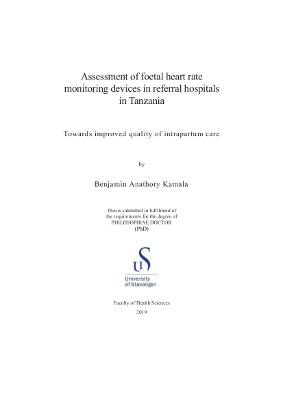Assessment of foetal heart rate monitoring devices in referral hospitals in Tanzania: Towards improved quality of intrapartum care
Keywords:
graviditet, fødsel, fosterlyd, dødfødsel, Doppler, MoyoSynopsis
Background: There are 2.5 million neonatal deaths that occur globally each year: 25% of them secondary to labour complications (intrapartum related). In addition, 2.6 million stillbirths occur globally each year, 40% of them intrapartum related termed as fresh stillbirth (FSB). Moreover, more than 80% of neonatal deaths occur in low-income countries (LICs). Almost 50% occur in Sub-Saharan Africa, where the supply of service does not match with the demand of service provision. These deaths can be substantially reduced by improving quality of care around time of labour and childbirth. Intrapartum foetal heart rate (FHR) monitoring and partograph use form an important component of quality of care provision. In LICs, where most births occur, FHR assessment is mostly done intermittently and mainly using Pinard stethoscope and rarely with hand-held Doppler devices. The effectiveness of assessment devices to detect FHR abnormalities in relation to the improvement of quality of intrapartum care is scarcely documented. An FHR monitor called Moyo, was designed for low-resource settings. The monitor can be used intermittently or strapped on for continuous FHR monitoring during labour. Aims: The overall aim of this PhD project was to compare the effectiveness of different FHR monitoring devices and the associated improvement in quality of intrapartum care at two urban referral hospitals in Dar es Salaam, Tanzania. Methods: We conducted three studies from 2013 to 2017. The studies included singleton women in the active phase of the first stage of labour who had normal baseline FHR on admission. Study I applied a randomized controlled study design between April 2013 through September 2015 at Muhimbili National Hospital. Hand-held Doppler (n=1,421) and Pinard stethoscope (n=1,423) arms were compared in their effectiveness to detect abnormal baseline FHR. Secondary outcomes were time to childbirth, mode of childbirth, and perinatal outcomes, including Apgar score, bag mask ventilation, admission to neonatal unit, FSB and 24-hour neonatal deaths. Study II was a follow-up of Study I and applied a randomized controlled design at Muhimbili between February 2016 through September 2017. Strap-on automatic FHR monitor, Moyo (n=1,479) and intermittent Hand-held Doppler (n=1,494) arms were compared in their effectiveness to detect abnormal baseline FHR. Secondary outcomes were time intervals in labour, mode of childbirth and perinatal outcomes (as in Study I). Study III was a preand post-implementation study design, conducted at Temeke Regional Referral Hospital, concurrently with Study II. In the pre-implementation period, intermittent monitoring was applied with a Pinard stethoscope (March through June 2016, n=1,640), whereas in the postimplementation period, strap-on automatic Moyo was applied (July to mid-December 2016, n=2,442). The primary outcome was detection of abnormal baseline FHR. Secondary outcomes included frequency of assessment of FHR, partograph documentation, time intervals, intrauterine resuscitations and perinatal outcomes. Results: In Study I, the Hand-held Doppler was found to be superior to the Pinard stethoscope (6.0% vs 3.9%, p=0.008) in the detection of abnormal baseline FHR during labour. Overall, perinatal outcomes did not differ between the two arms. However, post-hoc analysis showed that, for new-borns with abnormal FHR whose mothers had given birth vaginally, the composite adverse outcomes (neonatal unit admissions and perinatal deaths) were less prevalent in the Doppler arm (7 of 43 births, 16.3%) than in the Pinard arm (10 of 23 births, 43.5%), p=0.021. Study II, building on the results of Study I, showed that the Moyo was superior to the Doppler (13.3% vs 9.8%) (p=0.002) in the detection of baseline FHR abnormalities. The results for the time from admission to detection of abnormal FHR and from last FHR to birth were shorter in the Moyo arm than in the Doppler. However, the time from detection of abnormal FHR to birth was approximately 31% longer in the Moyo compared to the Doppler. Caesarean section rates were higher with the Moyo (19%) arm compared to the Doppler (13%) (p=0.031). Overall, perinatal outcomes did not differ between the two arms. In Study III, the Moyo was found to be superior to the Pinard (8.0% vs 1.6%) (p<0.0001) in the detection of baseline FHR abnormalities. Time from admission to birth and from last FHR to birth was shorter in the Moyo arm than the Pinard. The quality of intrapartum care provision improved significantly post-implementation in the Moyo arm. These included partograph use/documentation (98% vs 54%), and frequency of FHR monitoring (every 60 min vs 150 min). Other improvements included intrauterine resuscitations, and vacuum extraction of 5.8% vs 2.2% post- versus pre-implementation, respectively. Conclusions: This PhD project shows that the Hand-held Doppler was superior to the Pinard in the detection of abnormal baseline FHR. Further, it showed that implementation of strap-on automatic FHR assessment with the Moyo led to earlier and more frequent detection of abnormal FHR at the referral hospitals. This implementation was associated with improved quality of intrapartum care and partograph use. Moreover, the time from detection of abnormal FHR to birth was longer in the Moyo groups. Implementation of studies coupled with timely obstetric responses and powered to detect differences in perinatal outcomes are recommend.


